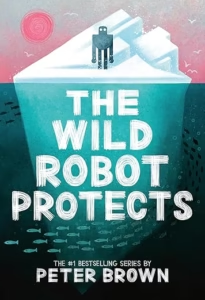The Wild Robot Protects (The Wild Robot #3)
Peter Green
Little, Brown BFYR
Published September 26, 2023
Amazon | Bookshop | Goodreads
About The Wild Robot Protects
Life for Roz and the animals on their island is wild, natural, harmonious. Her son Brightbill has even found a mate! But then, one day an injured seal washes ashore and warns of dangerous, cloudy waters that are flowing toward the island—and soon the animals are forced inland to fight over dwindling resources.
Roz calms and organizes the animals, but the poison tide takes a terrible toll on the island. And when the robot discovers that her new body is waterproof, she marches into the waves and sets out across the ocean, determined to stop the poison tide.
During her undersea journey, Roz encounters amazing geological formations and incredible creatures, and she sees the devastation caused by the toxic waters. Creatures she meets along the way direct her to a mysterious character known as the Ancient Shark, who explains that the poison tide is caused by a huge station that floats on the waves; a station operated by humans and by robots. To stop them, the Ancient Shark is prepared to attack with an army of sea creatures. However, Roz hopes to find a peaceful solution, instead. Can the wild robot save the ocean and her island and everything she loves?
My Review
This is the first middle grade series that my littlest and I enjoyed together. We had so much fun reading about Roz and her friends and everything she does to protect them and learn about the world. This story focuses on a threat to the environment and the animals on Roz’s island home. She sets out to find the source of the threat and stop it somehow. Her journey takes her across vast oceans where she meets other creatures and eventually learns what endangers her friends.
Like the other books in the series, this one contains short chapters (there are 80 in the whole 288-page book) with illustrations sprinkled throughout the text. My daughter loved getting to see Brightbill and his mate form a new family and for Roz to become a grandmother.
The whole story is really sweet. It reminds me a little bit of Charlotte’s Web in that it doesn’t shy away from the natural order. Some characters die, but their deaths are minimally discussed. It felt very age-appropriate to me, and she seemed to have no issues understanding what was happening or worrying more than an appropriate amount over something that happened.
Readers triggered by death, especially death of an animal should tread carefully, but I think that overall, those are handled really well within the context of the story.
Green also briefly explores the relationship between humans and machines and humans and the environment. While that’s a big, heavy topic, the story stays hopeful and leaves readers with an overall positive view of humanity.
I love this series. The short chapters make it an easy read-aloud or a great book for readers transitioning from chapter books to longer middle grade novels.
Content Notes
Recommended for Ages 8 to 12.
Profanity/Crude Language Content
None.
Romance/Sexual Content
Roz’s son Brightbill (a goose) finds a mate and eventually has goslings.
Spiritual Content
None.
Violent Content
Situations of peril. References to death and harm to animals from the toxins in the water. For example, early in the book, a seal washes up on the shore of the island with swollen eyes and a bloody nose after exposure to the tide. The seal later goes back into the water and drifts away. The narrative doesn’t specifically say the seal perishes.
A fire breaks out on a human base, threatening the lives of the workers and destroying some of the robots there.
Drug Content
None.
Note: This post contains affiliate links, which do not cost you anything to use but help support this blog. I received a free copy of this book in exchange for my honest review. All opinions are my own.
